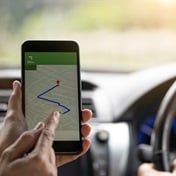- A team of engineers and researchers from the Korea Advanced Institute of Science & Technology (KAIST) is currently developing a humanoid robot that can fly aircraft without needing to modify the cockpit.
- For more stories, visit the Tech and Trends homepage.
Both artificial intelligence (AI) and robotics have made significant strides in recent years, meaning most human jobs could soon be overtaken by technology - on the ground and even in the skies above us.
A team of engineers and researchers from the Korea Advanced Institute of Science & Technology (KAIST) is currently developing a humanoid robot that can fly aircraft without needing to modify the cockpit.
"Pibot is a humanoid robot that can fly an aeroplane just like a human pilot by manipulating all the single controls in the cockpit, which is designed for humans," David Shim, an associate professor of electrical engineering at KAIST, told Euronews Next.
The robot, dubbed "Pibot," can control its arms and fingers to dextrously operate the flight instruments, even with severe vibration in an aircraft, using high-precision control technology.
Its external cameras allow Pibot to monitor the current state of the aircraft and the internal ones help it manage essential switches on the control panel.
Pibot is able to memorise complex manuals presented in natural language, a feat that enhances its adaptability across various aircraft.
Its memory is so large that it can memorise all of the Jeppesen aeronautical navigation charts around the world, which is impossible for human pilots, according to the KAIST team.
"Humans can fly many aeroplanes, but they do have these habits built into them. So when they try to convert to different aeroplanes they have to take another qualification. Sometimes this is not that simple because our habit remains in our mind that we can’t simply change from one to the other," said Shim.
“With the pilot robot, if we teach individual aeroplane configuration, then you can fly the aeroplane by simply clicking the aeroplane's type,” he added.
‘GPT made paramount progress’
The research team says Pibot “understands” and memorises manuals originally written for humans thanks to recent advances in large language models (LLM).
Shim explained:
Thanks to LLM, Pibot is expected to operate error-free flight, being able to react far quicker than its human counterparts in emergency situations.
It can memorise aircraft operation and emergency manuals (QRH, an in-cockpit manual for the flight crew to refer to in case of in-flight problems) and respond immediately. It can also calculate a safe route in real-time based on the status of the airborne aircraft.
While using ChatGPT, the research team is also currently developing and testing its own natural language model so that Pibot can make queries without relying on an Internet connection.
The tailored language model will handle information exclusively about piloting and will be stored in a small computer that can be carried onboard.
Flying alone or as a copilot
Pibot can also be plugged into aircraft to directly communicate with them. It’s currently designed to be deployed in extreme situations where human involvement may not be beneficial.
The humanoid robot can also communicate with air traffic controllers and humans in the cockpit using voice synthesis, allowing it to act as a pilot or a first officer.
Its adaptability goes beyond the aviation sphere. Standing at 160 cm and weighing 65 kg, Pibot's humanoid design allows it to seamlessly replace humans in roles like driving automobiles, operating tanks, or even commanding ships at sea.
Shim says this robot can be used for any place where a human is currently “sitting and working”.
He added:
The robot is still in development and is expected to be completed by 2026.
The research project was commissioned by the Agency for Defense Development (ADD), the government body charged with research into defence technology in South Korea, according to KAIST. Shim anticipates potential military applications in the future.
Watch the video above for more.




 Publications
Publications
 Partners
Partners























